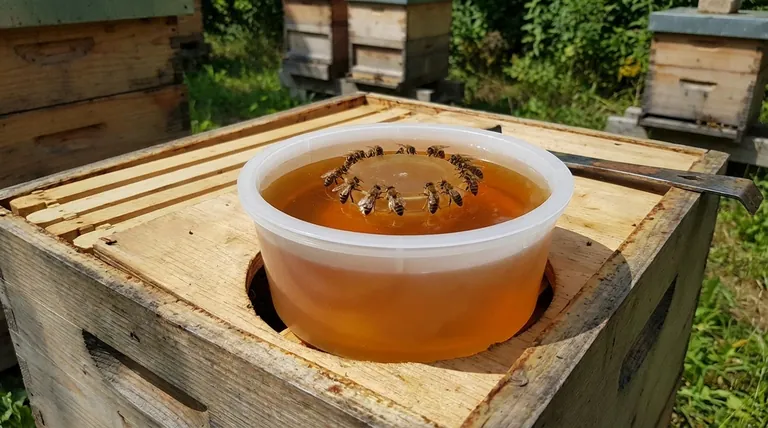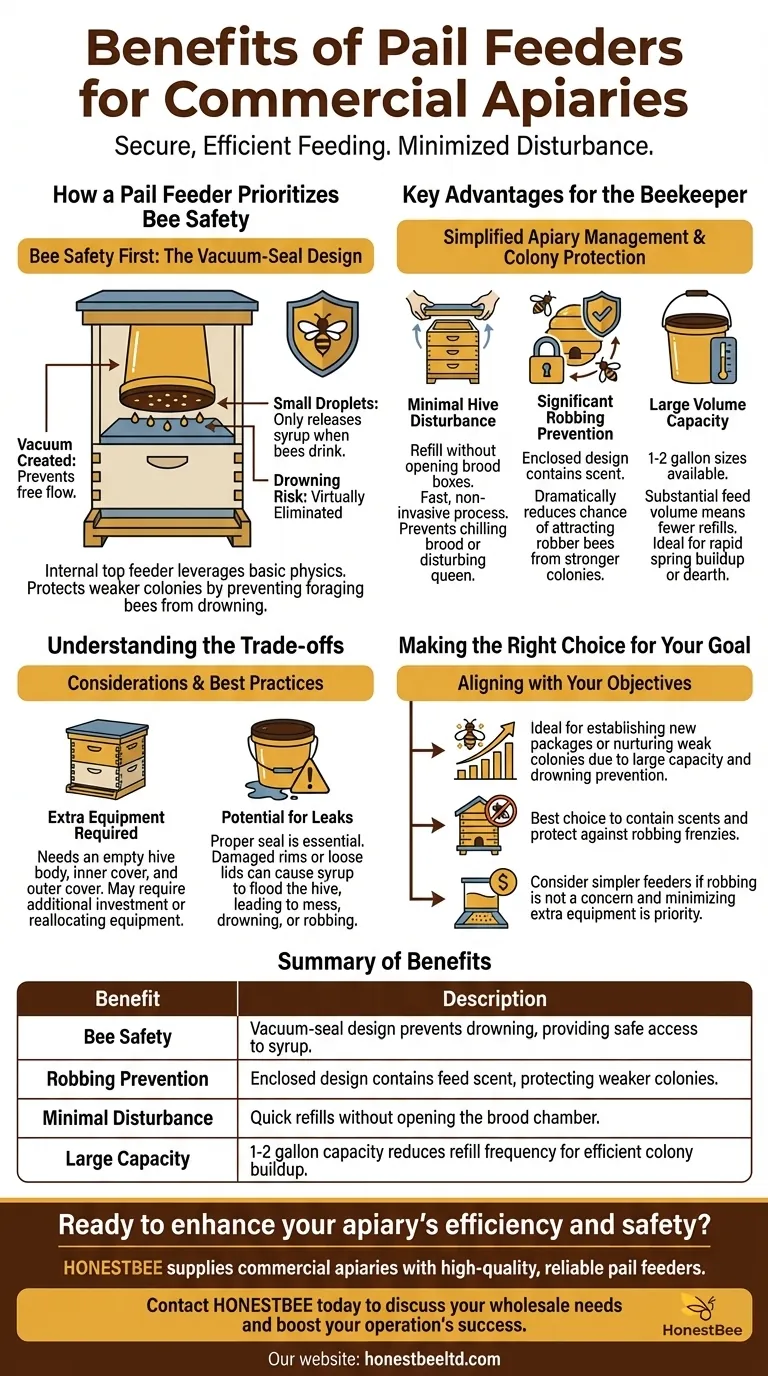In short, pail feeders offer a secure and efficient way to feed bees by minimizing hive disturbance, preventing robbing from other colonies, and virtually eliminating the risk of bees drowning in the syrup. Their design allows for a large volume of feed to be provided directly above the cluster, making them easy for the beekeeper to refill and for the bees to access.
Pail feeders represent a strategic choice for beekeepers prioritizing colony safety and feeding efficiency. Their core benefit lies in an enclosed design that protects the feed from outsiders while providing safe, easy access for the hive's bees.

How a Pail Feeder Prioritizes Bee Safety
The primary advantages of a pail feeder stem directly from its simple yet effective design. It is a type of internal top feeder that leverages basic physics to create a safe feeding station.
The Vacuum Seal Design
A pail feeder is simply a bucket with a tight-fitting lid. Tiny holes are drilled or punched into the lid.
When filled with syrup and inverted over the inner cover's hole, a vacuum is created. This pressure prevents the syrup from pouring out, releasing it only when bees drink from the holes.
Eliminating the Risk of Drowning
This vacuum-and-drip system is a critical safety feature. Unlike open-style top feeders or frame feeders where bees can fall in and drown, a pail feeder only exposes bees to a tiny droplet of syrup at a time.
This makes it one of the safest internal feeding methods, especially for weaker colonies that can't afford to lose foragers.
Key Advantages for the Beekeeper
Beyond bee safety, pail feeders offer significant practical benefits that simplify apiary management and protect the colony's resources.
Minimal Hive Disturbance
The feeder sits on top of the inner cover, enclosed by an empty hive body and the outer cover. To refill it, you only need to remove the top two layers.
This allows you to add feed without breaking open the brood boxes, disturbing the queen, or chilling the brood. The process is fast and minimally invasive.
Significant Robbing Prevention
Robbing, where bees from stronger colonies steal resources from weaker ones, is a major threat. Entrance feeders are notorious for starting robbing frenzies because the feed's scent is exposed at the hive entrance.
Because a pail feeder is entirely enclosed within the hive, its scent is contained. This dramatically reduces the chance of attracting bees from other hives, protecting your colony from attack.
Large Volume Capacity
Pail feeders typically come in one or two-gallon sizes. This large capacity means you can provide a substantial amount of feed at once, reducing the frequency of refills.
This is especially valuable when trying to build up a new colony quickly in the spring or when providing food during a nectar dearth.
Understanding the Trade-offs
While effective, pail feeders are not without their practical considerations. Understanding these trade-offs is key to making an informed decision.
The Need for Extra Equipment
Using a pail feeder requires an empty hive body (a deep or medium super) to place around the pail. You also need an inner cover and an outer cover.
If you don't have spare hive bodies, this method can add an extra cost or require you to pull equipment from another hive.
Potential for Leaks
A proper seal is essential. If the lid is not on tight or if the pail's rim is damaged, the vacuum can fail, causing the entire volume of syrup to leak into the hive.
This can create a sticky mess, drown bees, and potentially trigger a robbing event if the syrup runs out of the entrance. Always double-check your lid before inverting the pail.
Making the Right Choice for Your Goal
Deciding on a feeder depends entirely on your specific objective for the colony.
- If your primary focus is safety and rapid buildup: The pail feeder's combination of large capacity and drowning prevention makes it ideal for establishing new packages or nurturing weak colonies.
- If your primary focus is preventing robbing: The pail feeder is one of the best choices, as its enclosed design contains scents far better than entrance or open-air feeders.
- If your primary focus is ease of use and minimal investment: You may find an entrance feeder simpler if robbing is not a concern, as it requires no extra hive bodies.
Ultimately, choosing a pail feeder is an investment in the security and efficient growth of your colony.
Summary Table:
| Benefit | Description |
|---|---|
| Bee Safety | Vacuum-seal design prevents drowning, providing safe access to syrup. |
| Robbing Prevention | Enclosed design contains feed scent, protecting weaker colonies. |
| Minimal Disturbance | Quick refills without opening the brood chamber. |
| Large Capacity | 1-2 gallon capacity reduces refill frequency for efficient colony buildup. |
Ready to enhance your apiary's efficiency and safety?
HONESTBEE supplies commercial apiaries and beekeeping equipment distributors with high-quality, reliable pail feeders and other essential beekeeping supplies through our wholesale-focused operations. Ensure your colonies are protected and well-fed.
Contact HONESTBEE today to discuss your wholesale needs and boost your operation's success.
Visual Guide

Related Products
- Rapid Bee Feeder White Plastic 2L Round Top Feeder for 8 or 10-Frame Bee Hives
- Professional Hive Top Bee Feeder for Beekeeping
- HONESTBEE Professional Hive Top Bee Feeder Feeding Solution
- HONESTBEE Round Hive Top Bee Feeder for Syrup
- Classic Boardman Entrance Bee Feeder Hive Front Feeding Solution
People Also Ask
- Do beekeepers leave honey for bees? The Essential Guide to Sustainable Hive Management
- Can you dilute honey and feed it to the bees? Understand the Critical Risks and Safe Practices
- Can sugar syrup contaminate the honey crop? A Beekeeper's Guide to Protecting Honey Purity
- What are the recommended sugar-to-water ratios for making sugar syrup for bees? Optimize Your Hive's Health
- What is the advice regarding feeding bees to limit brood production based on? Managing Prolific Bee Strains



















